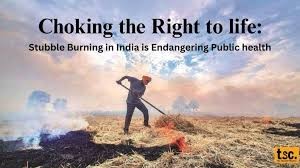Stubble burning goes against the right to live in a pollution-free space (Prelims & Mains- Environment)
Why in news?
Recently, the Supreme Court emphasised that stubble burning is not merely an issue of breach of law, but it constitutes a violation of citizens’ fundamental right to live in a pollution-free environment, guaranteed under Article 21 of the Constitution.

What causes stubble burning?
Some north Indian states have two growing seasons: one from May to September and another from November to April. Many farmers rotate between crops, planting rice in May and wheat in November. To quickly prepare the fields for the wheat crop, many farmers simply burn leftover plant debris after harvesting rice. The practice is known as stubble burning.
How does stubble burning cause pollution?
Burning stubble is a major cause of pollution because it releases toxic pollutants into the atmosphere:
- Gaseous pollutants: Carbon Monoxide (CO), methane (CH4), carbon dioxide(CO2), nitrogen oxide(NO2), and volatile organic compounds (VOCs).
- Particulate matter: Particulate matter causes respiratory disorders. PMs include PM10 and PM2.5.
- Other pollutants: Stubble burning also releases carcinogenic polycyclic aromatic hydrocarbons.
Significant impacts of pollution from stubble burn?
- As these pollutants spread in the surroundings, they form a thick layer of ‘smog’, which has a detrimental effect on air quality and people’s health.
- Another impact of this is on soil fertility. When the husk is burnt on the ground, it often affects the nutrients present in the soil and reduces fertility.
- According to a 2008 World Health Organisation (WHO) report, toxic air due to pollution kills about 7 million people annually worldwide. In 2012, The Energy and Resources Institute (TERI) reported that air pollution had led to about 5 million deaths in South Asia, which is around 22 percent of the total deaths in the region.
What Supreme Court Said?
- The Supreme Court criticised the Centre for making environment laws ‘toothless’ and stated that the provisions under the Commission for Air Quality Management (CAQM) Act, which was related to penalties for burning stubble.
- The bench hearing the matter said that the act was enacted without creating any required machinery for implementing the provision of curbing air pollution.
- The Union of India has not created machinery. Environmental Protection Act has become toothless. Punishment replaced with penalty by amending Section 15, and the procedure to be followed for imposing penalty cannot be followed.”
- The court said the authorities had failed in not only effectively implementing existing laws but allowed blatant violation of fundamental rights guaranteed under Article 21.
- The fundamental right vested in every citizen under Article 21 of the Constitution is to live in an environment free of pollution.
Steps taken by the government:
The Commission on Air Quality Management in NCR and Adjoining Areas (CAQM) has developed a framework and action plan for effective prevention and control of Stubble Burning. The framework/action plan includes:
- In-situ Crop Residue Management- Supported by the CRM Scheme of the Ministry of Agriculture for the activities – CRM machines procurement, setting up of Custom Hiring Centers, high yield and short duration paddy varieties, staggering of harvesting schedule, extensive use of bio-decomposer by IARI
- Ex-situ Crop Residue Management- Alternative usage of paddy straw viz. Biomass Power Projects, Co-firing in Thermal Power Plants, Feedstock for 2G Ethanol plants, Feed stock in Compressed Biogas plants, fuel in industrial boilers, WTE plants, packaging materials, etc.
- Prohibition of stubble/crop residue burning
- Effective monitoring/enforcement
- Schemes to reduce the generation of paddy straw
- IEC activities for the plan of action
- Standard protocol for recording and monitoring of fire counts.
Way forward:
- Promote agri-implements with subsidy
Recommendation on agri-implements: Augment subsidy and make it accessible to a larger number of farmers. Promote co-ownership models for the agri-implements
- Utilise crop-residue fuel in biomass-based power plants
- Use of crop residues for the production of biofuels and fertilisers
Recommendation: Prioritize biofuel by mandating its use in specific sectors
- Utilize as raw material for biomass pellets and other uses
Recommendation: Fiscal support to promote biomass-based products in specific sectors
- R&D and crop diversification
Recommendation: Support research projects that can work towards reducing crop residue generation Crop residue collection mechanism


